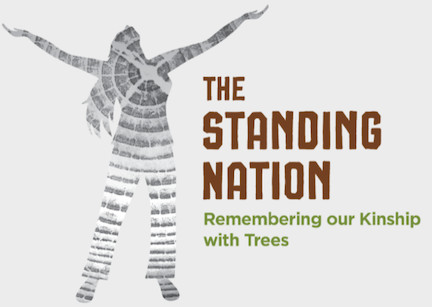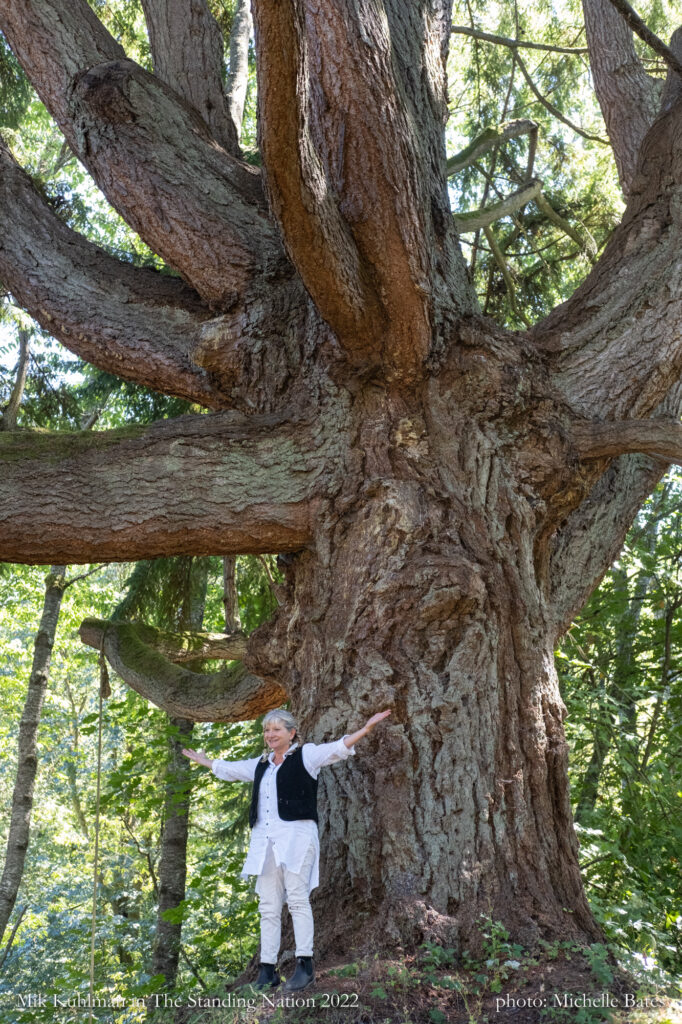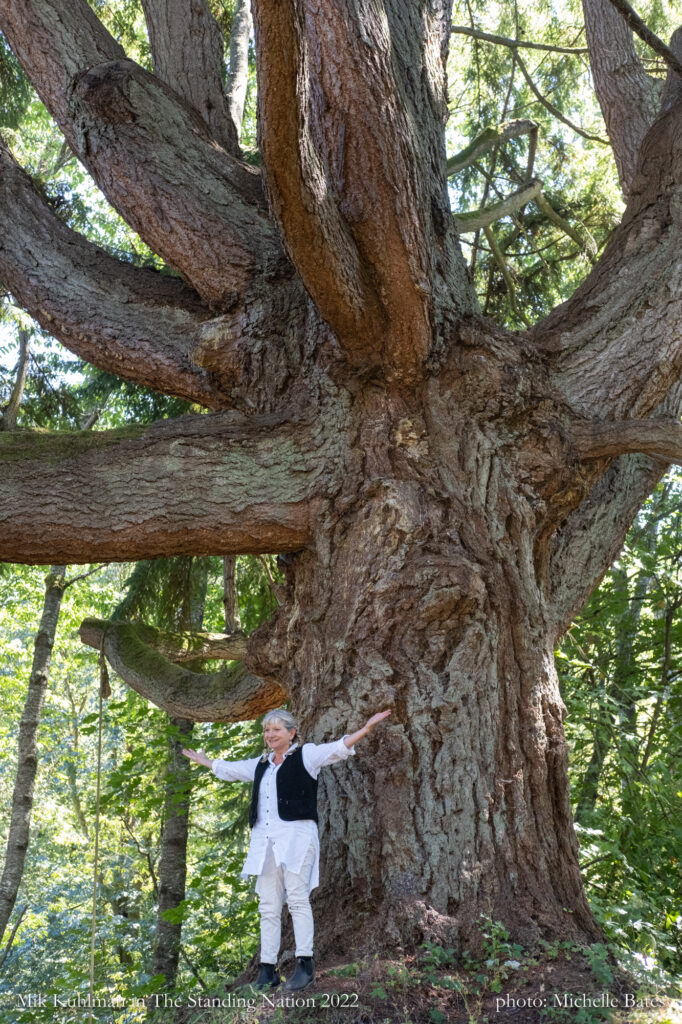By Jane Valencia

In May 2022, I attended a private performance of Mik Kuhlman’s one-woman show, “The Standing Nation – Remembering Our Kinship with Trees.” We gathered around an old and large Bigleaf Maple in a field. The tree itself was both theater and a centering presence, around which the show wove. Mik engaged with the tree, and the tree – through its nature – with her and with us, the audience. Nearly two years later, when I recall the experience, I am again enchanted. Thus, I met with Mik for a conversation.
“We started with all my collaborators for tea under a tree,” Mik says “With the tree’s presence there from the very beginning.”
“The Standing Nation” may be a one-woman show, but it relies on many to bring it to fruition and sustain it. “It was really powerful, I think, because a lot was said without being said. And it’s guided the whole piece ever since, because I am trying to come from a place of allowing. I’ve been saying, I’m going at the speed of trees. That’s how it started, at that level – where it all began. And it informs everything.”
The Standing Nation developed over the course of two years.
“As a solo performer, creator, theater-maker, it really takes me about 10 performances, and then I start to know and understand what the show is. It takes that long because the audience is part of the equation, the exchange. And then there’s the tree, which is like a partner or the world.”
Over the two summers of the development process, during the pandemic, Mik performed 23 shows for 475 people, taking 20 people at a time into the forest.
“I feel like [the show] is no longer a little sapling – it’s recognizably a tree. I feel like it’s got enough growth that it’s at that stage where a teenager goes off for college, right? Where they really are developed, they really can do their own laundry. The show feels like that on that level. It feels developed. Now, it’s nuance for me. There’s some interactive work that I have dreamed of that I haven’t done yet. For example, I would love some spruce tea and to have a plank of wood that, as you come out of the forest, you get this sip of spruce tea.”
We spoke of the three trees that were central to those performances. I mentioned how, in the private show I’d attended, I’d been charmed by Mik’s use of a beautiful nook in the tree, in which she rested her head.
“And the first tree, in the Burton Woods didn’t have a place for me to nook in, and there’s nowhere to sit.” Attendees had to walk down a trail to arrive at the tree.
The third tree was an “octopus mother tree” with a big root ball.
“She’s just in a yard,” Mik describes, “and she’s a 250-year-old Douglas fir that did not go straight, and that grew into a forest on herself.” Approaching this tree is like entering a portal. As you approach, “You first go, ‘Okay, that’s a beautiful big tree.’ And then you go under her canopy and your jaw drops. You just walked under into a forest. It’s unbelievable.”
Mik continues, “And so the beauty of this show is that there’s a tree. And the tree has things to say, too, and it’s not speaking in words and thoughts. It speaks in oils, and it speaks in scents. When we walk into a forest, we can smell it. We inhale, we breathe deeper. It’s medicine to us in a very powerful way. So they talk. It’s another language, and it’s been fun to just dip into this as an artist.”
The Standing Nation came about, perhaps, as a result of the pandemic.
Mik Kuhlman had been offered a slot in the Vashon Repertory Theater’s first summer festival with a particular play that she really loved, “But it was dark, and I just felt like ‘that’s not what people need right now.'”
Mik explains further, “COVID changed me, in making me think twice. It’s not ‘What do I like,’ but ‘what does the world need right now?'”
Specifically, she wanted to do something about climate mitigation. “I feel that we as individuals, every single one of us, has to stop and ask ourselves, what can I do right now? Because I have to. We have to. And so as an artist, it made me say, ‘I have to do something that brings what I’m here on the earth doing, and my trainings and skills and efforts and time and dedication.'”
But what?
In a phone conversation with her longtime friend and collaborator, screenwriter Tess Clark, Mik mentioned her desire to do a piece about the environment.
“I have some beautiful western hemlock forest that I see from my windows, and I was staring at their tops. And Tess said, ‘I know what you should do. You should do a piece about trees. I just read this beautiful article in the New York Times Magazine from Suzanne Simard, and you even look like her.’ And it felt like the North compass just walked itself right into place.” And I was like, ‘Yes. That’s it.'”
At the time, Tess was in her own exploration of plant life, asking: What’s this plant called, what’s native to my area, what are these plants in my yard?
She offered to write the piece. Initially, the writing was difficult. Finally a friend suggested, “Take your healer self and go into the woods. What would you tell people about based on all of this?”
This was a turning point. “We zeroed in on female scientists who are out there in the field doing the work,” Mik shared. “And then we zeroed in on this concept of things being in threes: the three women, and how about three trees and their relationships? Who are the trees that we know? So Luna, everybody knows Luna and Julia Butterfly Hill, that story …” And The Standing Nation began to sprout.
“Tess had the exact essence to be able to speak for the trees, because she speaks from her heart, and has always really driven in the world from her heart. So it was these two really powerful pathways in that had instant openings, because they’re from the heart.”
To be continued.
For more information, please visit: Mikkuhlman.com


